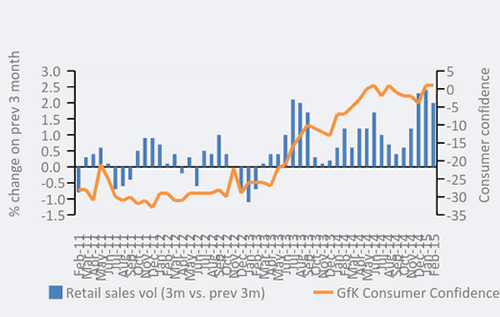Retail sales slow in February but outlook still positive
Retail sales showed robust growth in February as positive economic fundamentals continue to underpin consumer spending and confidence. According to the ONS, retail sales were up by 5.1% (volume, exc. automotive fuel), the 23rd consecutive month of year-on-year growth and the longest period of sustained growth since May 2008 when there were 31 periods of growth. The underlying pattern in the three month on three month movement in the quantity bought continued to show growth for the 24th consecutive month, increasing by 2.0% - but slowing from the 12 year high in the three months to January.These latest figures show retail sales slowing a tad but remaining robust by historical standards. We remain upbeat on the strength of future retail sales with rising real incomes, record levels of employment and strong consumer confidence supporting spending over the course of the year. We forecast consumer spending to rise at an annual rate of c.3.0-3.5% in 2015.Low inflation and nominal wage growth is boosting households’ real incomes. Falling prices across non-discretionary items of the consumer basket such as petrol, food and utility bills, is boosting disposable income. Average store prices (including petrol stations) fell for the eighth consecutive month, falling by 3.6% in February 2015 compared with February 2014. This is the largest year-on-year fall since consistent records began in 1997. The largest downward contribution came from petrol stations, which fell by 15.5%, the largest year-on-year fall in this store type on record. Even excluding petrol, shop prices fell by an annual 2% - consistent with the BRC’s Shop Price Index which recorded deflation of 1.7% in February.Deflationary pressure has been particularly strong across the food sector which has seen prices fall because of intense competition from the discounters and the impact of softer commodity prices and cheaper imports being passed on to consumers. Chart 1: Shop prices have fallen sharply

Source: BRC-NielsenOnline sales continued to perform strongly, up 10.3% year-on-year (value, non-seasonally adjusted). Online sales accounted for 11.6% of total retail sales in February. Average weekly spending for online retail reached £684.2 million in February, up from £620.2 million in the same month last year. February was the lowest average weekly spending month in 2014 for online and total retail. The latest data for consumer confidence showed a notable rise in March 2015. All five measures for consumer confidence increased with the overall measure reaching +4 – the highest for almost 13 years. This bodes well for spending in the first quarter of 2015. The trajectory of consumer confidence can act as a useful forward looking indicator for the path of consumer spending (chart 2).Chart 2: Retail Sales (3m vs. prev 3m) and consumer

Source: ONS, GfK, Retail Economics analysisWe remain confident that household goods and consumer electricals will benefit from stronger underlying conditions for consumers. Although the housing market slowed towards the end of 2014, stamp duty reforms, record low mortgage rates and increasing supply of credit will revitalise house moves in the coming months. Furniture, flooring and household goods are likely to be major benefactors. More competitive personal loan rates will spur on demand for big-ticket items such as kitchens and bathrooms. However, with the General election in May becoming ever-present, consumers may feel more cautious about spending in the immediate future. This has not yet been reflected in consumer confidence measures but, nevertheless, we see this as a potential risk given a hung parliament and the impending period of uncertainty is likely.
Back to Retail Economic News